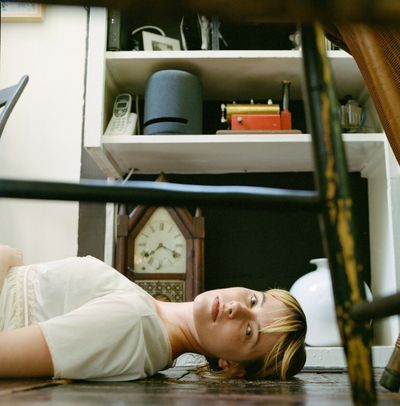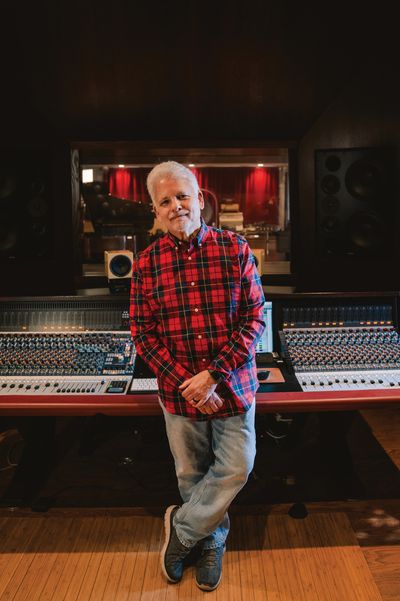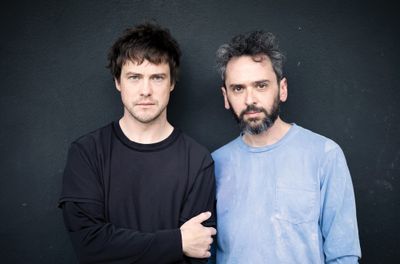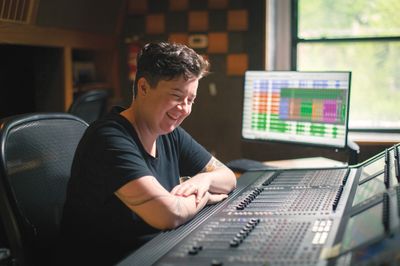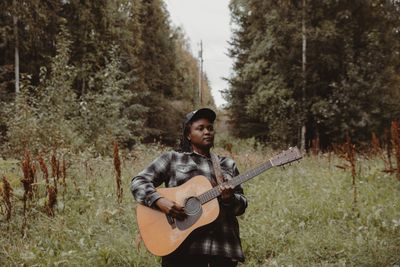I am pretty touched that Chris Koltay snuck mentions of you into the Tape Op gear reviews for half a decade. That’s friendship.
Wow, I didn't even know that. I would say he's probably the only reason why I'm getting this interview. [laughter] Koltay is definitely my sonic guide. I came from an era of producers in the early MySpace age. That transition from using a proper studio with a bunch of gear, to a bunch of kids in their bedrooms with Ableton [Live], or [Propellerhead] Reason, or [Steinberg] Cubase, or FruityLoops [Now Image-Line's FL Studio]. Producers from that era were taking the very raw, over-compressed, in-the-red approach. It was the sound of the time and Chris opened up my ears and mind to this magic area where you are paying attention to the rules but also disregarding them to create something really original. Before, I was like, "I'm going to take this voice memo, smash the fuck out of it, and use that as the main part of the song." Chris got my mindset to recognize this deserves to be mixed really well. I was ignoring part of the craft, and I was a very stubborn laptop producer. I was kind of like, "Fuck it. Throw it away." I'm a jazz school dropout. When I started working with Chris, I started to realize – my wave shouldn't be a chocolate bar. It should have peaks, valleys, and all this character to it. I started hanging out with Chris and listening to a lot of different music from a lot of different time periods and recognizing what made that stuff sound so good. I think a lot of people don't realize how much your engineer and your front of house guy is making it happen.
Cherry Blossom Baby is a very precise, meticulous record. Clearly you learned something from Chris Koltay over time.
The first ideas of this record probably started in late 2018, and they were just little skeletons of tracks. It was me drum programming right into Reason. I would put out a little beat on the [Elektron] Machinedrum and play a [Roland] JUNO with a key part, bass part, and drum part. I started working with KESSWA [Kesiena Wanogho], who's the main vocalist on this record. It’s just as much her record as it is mine. She would lay down these little infectious phrases. This was all little, simple jams and tests laying the vocals over these tracks. In 2019 and 2020, everything got crazy – I dipped off the map, like we all did. I was watching way too much TV, and didn't have a sleep schedule. There was a moment where I was like, "Oh man, I really want to get guitar on this." I'd been working on this boogie-like roller skate track, and I really heard my friend Sasha [Kashperko] in it. This was in the middle of the pandemic, when we were completely quarantined. I sent him that rough version, and I asked, "Can you just send me a bunch of takes?" He did, and immediately my inspiration returned because it felt like working with people again, even though we weren't in the same room. I hit up Tim Shellabarger, who's a bass player for Will Sessions, a great funk and soul group here in Detroit. He laced these tracks with the most incredible bass. I just kept hearing more players on [the record]. I think the focus was to get players that were part of my life throughout this time. We had all cut our ties down immensely. Our circle became much smaller. Our time became much more valuable about who we were spending it with. We became more sensitive to vibes that we weren't vibing with. To tangent a little bit – this Shigeto thing has been a solo project for so long – me and the drums, then it became me touring around the world with Koltay. And then, right before the pandemic, I started bringing out Marcus [Elliot] and Ian [Fink]. I love what I've been doing. I put all this work in – but I come from jazz; I come from bands. I'm not reaching these moments of magic on my own. I needed to start playing with other people so I could feel good again, so I could feel creative, and so I could feel happy. Once I had all these friends involved, it created a natural, genuine excitement. It felt really powerful to have a platform where I could actually get all these friends involved. Additionally, I wanted to be able to use the last 10 to 15 years with Ghostly International [label] to uplift these incredible players, because there's no lack of talent. You're never going to hear all the great music. You're never going to hear all the great producers. Without the collaboration with these people, I don't think an album would have come out.
You have a track record as a community builder and being vocal about local DIY scenes being the only sustainable way forward. You did a few performances to support the Living Wage for Musicians Act over this last year.
Yeah! As soon as they asked, I said, "Whatever you guys want me to do, I'm happy to try and help." [U.S. representative] Rashida Tlaib met with us on FaceTime – it was truly surreal and an honor. And it felt hopeful to be face-to-face with this politician who wants to try to do something about this. Musicians are getting put through the meat grinder. It's not sustainable. The way that people consume music now is insane. The environment we're in creatively, with this pressure to constantly pump out fleeting works of art for a fraction of a cent to stay relevant, or get playlisted, or whatever. It doesn't feel good. It's also hard because Ghostly is such a great label that embraces the future, while also trying to hold onto tradition. I feel very polarized. Part of me is like, "Support the musician's union!" Then, at the same time I'm like, "Listen to my single on Spotify." It's this constant push-and-pull of trying to fight for change, but then also drinking the Kool-Aid at the same time. It's going to be a long journey, but the good news is that it's not written yet. There are no rules right now. I think that's just going to happen until there's some sort of reform with how it's being done. This also goes back to what I was saying about community – if things like Spotify are how people are digesting it – the real shit is the live show. I don't know, maybe it was Dexter Gordon, a jazz musician – but they were like, "The record is only promo for the concert." That's how they always looked at the music industry.
I like that sentiment.
I still believe that. The record is not how we're paying our bills. It never was, unless you were part of a major label, and even then you could be in debt. As the listeners, we don't know what a band is going through, no matter how big they are. We have to focus on what's right in front of us, and that's the live show. That's when fans can connect with you directly in real time and feel good about it. I don't want to start a Patreon with all this random bullshit. I want to just have you guys come to the show.
You don't want me to pay for access to your healing journey over Patreon? That's the one that always gets me. We're paying for emotional access to artists rather than purchasing music in a fair way.
Right? This isn't it. [laughter]
In piecing together Cherry Blossom Baby, was it all emailing loops and collage over the pandemic? Did you finally get into the studio together?
It was a combination. The first stuff exchanged was audio – where I'd send them the track and rather than loops they'd record three different takes all the way through. Then I would start going through and cutting out little bits. I wanted the record to sound like a studio record, but it's very much a collage. It's pieced together from live takes that they'd send in. The final touches were live in the studio, like all the percussion that Dez [Andrés] did, all of Keth's vocals, all of Cleveland Thrasher’s vocals, and all of Tammy’s [Lakkis] vocals. Basically, I wrote these songs and then Ian would come in and reharmonize them and make them a hundred times better. 2020 was all sending files back and forth. Then 2021 to 2023 was just session after session, adding little bit after little bit. It was my first record I felt I was producing. I've never worked on a project where I'd sit on a track for months and then say, “I'm going to add a glockenspiel.” [laughter]
I noticed the glockenspiel. Glockenspiel juxtaposed with rhymes like “top down with surround sound.”
I love that, because she [KESSWA] improvised that section too. It was completely freestyle.
What were you leaning on during these live studio sessions that felt like your workhorses?
You know what? I'm going to walk out to the studio.
These live sessions, were they in your studio?
Oh, yeah. They were in my studio.
Does your studio have a name?
It's called the Portage Garage. My brother and I bought a house and a garage in Hamtramck, Michigan, eight years ago. This garage was an old auto garage, and before that it was a Mobil gas station. I believe the building is from the 1930s. Then it was a guy making neon signs; he sold it to us, and we converted it into a ceramic studio and a music studio. We run a label together called Portage Garage Sounds. PGS is our father's initials, so that's a nice little nod to our dad. It's nothing fancy, but the thing that's really great about it is that it is soundproof. It's a great rehearsal room, and it gets used constantly for bands because there's nowhere you can play all night at a loud volume and not be paying a shitload of money. It's a nice live room, then there's one main room, and then a little isolation booth used as a kind of studio B vocal booth.
You're not old-schooling it with cardboard boxes over your head?
[laughter] No, no. It's definitely been done. The main kind of workhorse for me on this record was my laptop running Reason. I've been using reason since Reason 2.0. My sound card was an Antelope Discrete. It has broken on me since then, but that was my favorite sound card that Koltay recommended.
You know, every time Chris Koltay mentions you in Tape Op gear reviews, he references you as a living legend. You should pay him back.
[laughter] So, the living legend Koltay suggests that sound card.
Walk me through the synths and hardware.
I use a Korg Delta – this nice combo of a simple synthesizer with a string mode. It doesn't have MIDI; it's just CV. I’m also using the [Roland] JUNO-Di. It’s the Guitar Center boy with all the little presets. I just run the JUNO through some compressors, and it would make it sound older. [laughter]
Hey, if it's working, it's working.
Yeah! I have an old Moog Micromoog that is a huge staple for me. That was all over Lineage, New Monday, and No Better Time Than Now. A lot of the synth bass was coming from a Moog Grandmother and also a Moog Sub 37. The drums were recorded kind of funny. I have the cheapest Shure kick drum mic you can get. I don't even know what the model is, but it's a hundred bucks. Then I have a [Shure SM]58 on the snare – that's running through that same compressor. Then I have one condenser mic made by Sterling Audio [for] overheads. The sound for this record was the first time I incorporated live drums on almost everything unless it's a trap beat. You can’t tell most of the drums were recorded live, because it has a super hard gate on it. It almost sounds like an [AKAI] MPC. It's getting rid of that live room sound and makes it more like it's sampled. That was the first time that I did that myself. Usually, I would have just recorded my drums and they would sound okay, then Koltay would mix that. This record, because I was in quarantine, I did it myself. A good friend of mine, Salar Ansari, is an incredible producer here in Detroit from Iran. He asked, “Why aren't you gating your drums in the mixer?” It sounded so much better, having super-fast gates at a super high volume. It made the sound so much more lively. When we did Versions, that was all Koltay – all at his studio, probably using like a $10,000 overhead mic. [laughter] You can hear the difference, but I think for this record, because it's so collage, it worked well. One of the special recurring guys is my Japanese frog block. So, that guy makes a lot of little cameo appearances. Most of the drums that were electronic weren't even from drum machines. It was all one-off sounds that I put into Reason. I was much more focused on live audio. There were a lot of samples I used from Splice. Shout out to them, because I never used to use samples. Not like I was against it; it's just not how I was making stuff. Over the years, I ended up working with Splice a lot, making multiple packs for them – and I was like, "Well, if I'm making these packs, I want to fuck around and see what they're about." They’ve been super fun and super helpful. If you want conversations at a bar with men and women in a busy Paris street – you can search, and it'll come up.
The sample in “Can't Keep Up” – is that from Splice and not from the bar on the street in Detroit?
[laughter] No, that one's a real one. Some of the vocal stuff is actual voice memos. A lot of the simple underlying percussive sounds are taken from Splice packs. I think a big thing in Detroit is people here in the '90s – in the start of the underground resistance – were making music with the gear that was available to them. It wasn't necessarily the best gear. It was what was turning up in pawn shops. They made do with what they had. That sound is using these things coming out of a Mackie in the red. That's the song. I feel like I've learned to let go of wanting specific things and just using the stuff that we have. I have no lack of gear, right? A lot of it is trends, a lot of it is hand-me-downs. It's all stuff that finds its way into your life. So, I'm into using it however it can be used. An elder musician told me the craziest story. He was saying that the Detroit techno sound basically formed due to racism. I asked, "What do you mean, besides the political side of it?" He said, "Well, at that time music gear was really expensive." Music gear is always expensive, but the new electronic stuff was very expensive. We couldn't afford this stuff. Everyone at that time wanted to buy American, so they were focusing on Moog, Dave Smith. They didn't want to buy Japanese. So, Yamaha and Roland started showing up in the pawn shops. We had access to Japanese gear because most people with money didn't want the Japanese gear. We could finally afford the stuff that we couldn't afford before. The whole sound of using Roland synths, Roland drum machines, and Yamaha gear – was born out of that.
Something I'm noticing in your pressers for Cherry Blossom Baby is your family tree. Your family was imprisoned in the U.S. in WWII for being Japanese. Add to this, a media partnership with Roland – a Japanese corporation – supported your live listening events on Bandcamp. A hard full-circle, but a full-circle between stories.
My grandmother was at the Tule Lake prison camp in California.
I share two cultural backgrounds between my parents, I know it feels complex as you age and process it. Your record is such an intentional love letter to a blend of cultures, class, technique, and a city where this is foundational. Detroit probably doesn't need us, but maybe we need Detroit.
[laughter] I mean – I wouldn't disagree. I set out to make my life here years ago – specifically for two things. One, because my family is here and we're getting older – but also to be a part of something bigger than me and never stop learning. I think that’s the double-edged sword of Detroit. The culture here is so real, invested in maintaining a sense of quality, and not giving in to hype. Standing by your philosophy of music, not making compromises. I think people here never stop trying to be better. I think when they do it's seen. I don't need to name names, but we know when people get lazy. Detroit is a place where it's really hard to get lazy. You're in such close proximity, you live every day with the creators at the coffee shop, at the show, and in the record store. You're always young because there are all these generations ahead of you. I say Detroit is like a Japanese grandmother who treats you like a baby even when you're 65. [laughter]
We're ending the interview. That's how we leave it. That’s the wisdom!
I don't even know if I'm answering that question, but it's leading into it, I think. My work on this album and the current state of shit. A cherry blossom is an overused, very cliche imagery in Japanese culture – but for me there are a couple things going into this. The pandemic was hard. But it’s not a pandemic record. I think we were all rethinking who we were at this time, especially if you weren't working and if you were in music or entertainment. You just stopped working. I was thinking, "Who am I, outside of this? Who am I, if I'm not out playing shows?" Musically, my biggest strength is a facilitator, a curator, and a connector. That came over years of thought during the pandemic of trying to figure out who I was. On the other side of it, I figured out I'm Japanese American. I mean, I'm Japanese Jewish American. I didn't really realize that I was a thing until this time of deep reflection. I'm a fourth generation Japanese American. That's very specific. I started learning that fourth generation JAs have Japanese middle names. I have Shigeto. My brother has Kenjiro [Ben Kenjiro Saginaw] – but we don't speak Japanese. The third generation don't have Japanese names, but they're still connected with the language. I started learning that this is normal, rather than me not knowing how to speak Japanese – or being considered gaijin when I go to Japan. Cherry blossoms bloom every spring in Hiroshima, which is where my family is originally from. Hiroshima was leveled to nothing – and still, the cherry blossoms bloom. That's me. That's us. That's how we have to be, as people. We have to be resilient but also malleable. We have to be able to change and grow in the harshest of circumstances, as well as when it's springtime. This record, for me, is so important because the idea was built around resilience. I think it was one of the first projects in my life where so many minds came together and actually felt honored, they felt included – there was no smashing of egos. I mean this could be off the record or not, but down to the splits in royalties every musician has something. There's equity in every person's role. That's part of this idea of community sustainability. We have to change the rules from the inside. We've got to lead by example. ![]()
